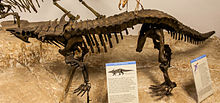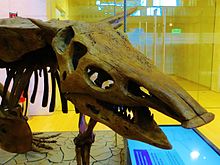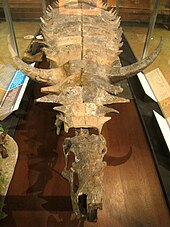Desmatosuchus
| Desmatosuchus | |
|---|---|

| |
| DesmatosuchusfromPetrified Forest National Park,Arizona | |
| Scientific classification | |
| Domain: | Eukaryota |
| Kingdom: | Animalia |
| Phylum: | Chordata |
| Class: | Reptilia |
| Clade: | Archosauria |
| Clade: | Pseudosuchia |
| Order: | †Aetosauria |
| Family: | †Stagonolepididae |
| Subfamily: | †Desmatosuchinae |
| Genus: | †Desmatosuchus Case, 1920 |
| Type species | |
| †Desmatosuchus spurensis Case, 1921
| |
| Species | |
| |
| Synonyms | |
| |
Desmatosuchus(/dɛzmætoʊsuːkəs/,fromGreekδεσμόςdesmos'link' + σοῦχοςsoûkhos'crocodile') is anextinctgenusofarchosaurbelonging to the OrderAetosauria.It lived during theLate Triassic.
Description
[edit]
Desmatosuchuswas a large quadrupedal reptile measuring 4.5 m (15 ft) to over 5 m (16 ft) long and weighing about 280–300 kg (620–660 lb).[2][3][4][5]Itsvertebral columnhad amphicoeluscentraand 3 sacral vertebrae. This archosaur's most distinguishing anatomical characteristics were itsscapulaewhich possessed largeacromion processescommonly referred to as "shoulder spikes".[2]The forelimbs were much shorter than the hindlimbs, withhumeriless than two-thirds the length of thefemurs.[6]Thepelvic girdleconsisted of a longpubiswith a strongsymphysisin the middle, a plate-likeischium,a highly recurvedilium,and a deep, imperforateacetabulum.[6]The femurs were relatively long and straight, the anklescrurotarsal,withcalcanealtubers that gave it large heels.[6]

Its skull was relatively small, on average about 37 centimeters long, 18 centimeters wide, and 15 centimeters high. The braincase was very firmly fused with the skull roof and palate. It had slender, forkedpremaxillaethat turned up and expanded in the front, creating a shovel-like structure.[2]Desmatosuchusis unique among aetosaurs in that its species are the only known aetosaurs that lacked teeth on their premaxillae.[2]Their premaxillae fit loosely together with theirmaxillae,indicating flexibility at that joint.[2]Their maxilla contained 10 to 12 teeth.[2]Desmatosuchusalso had very thinvomers,which bounded the medial side of theinternal nares.[2]These internal nares were relatively large, roughly half the length of the entire palate.[2]The lower jaw typically carried 5 or 6 teeth, and had a toothless beak on the end.[2]Thedentarywas about half the length of the lower jaw, with the front portion being toothless and covered by a horny sheath.[2]Behind the dentary was a moderately large mandibularfenestra.
Individuals ofDesmatosuchuswere heavily armored. Thecarapacewas made up of two rows of medianscutessurrounded by two more rows of lateral scutes. The lateral scutes had well-developed spine-likeprocesseswhich pointed out laterally and dorso-posteriorly.[7]There were typically five rows of spines, increasing in size anteriorly. The front spine was much larger, around 28 centimeters long, and was recurved. The fourth spine varies in length in each specimen, but remains shorter than the fifth in all of them.[2]Desmatosuchusare the only aetosaurs known to have possessed spines like these.[7]
Discovery and classification
[edit]The firstDesmatosuchusdiscovery occurred in the late 19th century whenE.D. Copeclassified armor from theDockum GroupinTexas,USA, as the new speciesEpiscoposaurus haplocerus.[8]Case later classified a partial skeleton found in theTecovas FormationasDesmatosuchus spurensis.[9]Since the localities of Cope and Case were only a few kilometers apart, the two taxa were synonymized intoDesmatosuchus haplocerus,the initial type species of the genus.[8]
A revision ofDesmatosuchusby Parker (2008) found thelectotypeofEpiscoposaurus haplocerusto be referable toDesmatosuchusbut indeterminate at the species level. Therefore,E. haploceruswas considered to be anomen dubiumandD. spurensiswas named thetype speciesof the genus. Two species were accepted as valid:D. spurensisandD. smalli,named after Brian J. Small for his contribution to the study of this genus.[10]Desmatosuchus chamaensisis recognized as a distinct genus, but there is some dispute about whether the nameHeliocanthusorRioarribasuchusapplies.[8]
The followingcladogramis simplified, after an analysis presented by Julia B. Desojo, Martin D. Ezcurra and Edio E. Kischlat (2012).[11]

| Aetosauria |
| ||||||||||||||||||||||||||||||||||||||||||||||||||||||||||||||||||||||||
Paleobiology
[edit]
Bones and armor pieces ofDesmatosuchusare abundant in the Dockum formation,Chinleformation, and Post quarry, indicating that they were widespread and abundant during the Late Triassic.[2]It is possible thatDesmatosuchustraveled in herds or family units. This is evidenced by several findings of multipleDesmatosuchusskeletons in relatively small areas.[2]
Desmatosuchushad blunt, bulbous, slightly recurved teeth. Furthermore, they are believed to have hadhomodontdentition.[2]This, combined with its shovel like snout, indicate thatDesmatosuchusfed by digging up soft vegetation.[7]This method of feeding is further evidenced by its toothless premaxilla and dentary tip, which were covered in horny sheaths. These sheaths protected the bones and could be used for cutting or holding objects.[12]It is believed thatDesmatosuchusdug for food in the soft mud near bodies of water due to the abundance of lakes and rivers in the Dockum area and the fact thatDesmatosuchusscutes are often found among parts of other reptiles that are known to have fed along waterways.[2]It is unknown whether or notDesmatosuchusreplaced their teeth and, if so, how. The low number ofDesmatosuchusteeth that have been discovered indicates that they were only held in place by soft tissue connections.[2]The jaw articulation point is below the tooth line, holding its upper and lower tooth rows parallel while biting in a way that is reminiscent ofornithischiandinosaurs.[12]

The armor and spikes ofDesmatosuchuswere its only ways to defend itself from predators. The lateral spike rows showed variation in size among individuals, especially the second most anterior spike. This spike was always shorter than the one in front of it, but to what extent varied drastically. This variation may indicatesexual dimorphism.[7]It has also been hypothesized as a form of sexual display.[2]Aside from this armor,Desmatosuchuswas defenseless from attacks from carnivores. SeveralDesmatosuchusbones have been found amongst skeletons ofPostosuchus,indicating predation byPostosuchus.[2]The herd nature ofDesmatosuchusapparently did little to discourage predators, asPostosuchusalong with several other Late Triassic carnivores also traveled in groups.[2]
Most thecodonts of the Late Triassic lacked certain pelvic features that aided locomotion, such as a deep acetabulum or a crest over the acetabulum. This, in spite of their upright posture, rendered them only slightly more mobile than sprawling reptiles.[13]Desmatosuchuspossessed both of these features, along with its long femur and elongate pubis, making it more mobile than most thecodonts of its time.[13]This mobility, along with its size, abundance, and specialized beak made it the chief herbivore in the Dockum area.[2]
It has also been suggested thatDesmatosuchuscould have been omnivorous or even an insectivore. This is because of several similarities betweenDesmatosuchusandarmadillos.[14]For instance, both groups are armored. They possess long snouts that lack teeth on the end. Also, there is evidence of bees, wasps, and termites in the Late Triassic, meaning thatDesmatosuchushad access to insects that armadillos prey on.[14]Their teeth are somewhat similar in shape, although armadillos have more peg-like teeth.[14]BothDesmatosuchusand armadillos typically carry around 6 teeth on their dentaries. Both armadillos andDesmatosuchushave hypertrophied processes present on their limb bones, which indicates large limb muscles.[14]This connection is more tenuous, however, sinceDesmatosuchushave a crest over their hind limbs but lack one on their forelimbs, meaning that they likely didn't have the musculature for digging with their forelimbs the way armadillos do. In spite of these parallels, the general consensus is still thatDesmatosuchuswas most likely herbivorous.[2] [13]
References
[edit]- ^Parker, William G. (June 2005). "A new species of the Late Triassic aetosaurDesmatosuchus(Archosauria: Pseudosuchia) ".Comptes Rendus Palevol.4(4): 327–340.doi:10.1016/j.crpv.2005.03.002.
- ^abcdefghijklmnopqrstuSmall, Bryan John (December 1985).The Triassic thecodontian reptile Desmatosuchus: osteology and relationships(Masters thesis).Texas Tech University.hdl:2346/19710.
- ^von Baczko, M. B., Desojo, J. B., Gower, D. J., Ridgely, R., Bona, P., & Witmer, L. M. (2021).New digital braincase endocasts of two species of Desmatosuchus and neurocranial diversity within Aetosauria (Archosauria: Pseudosuchia).The Anatomical Record, 1–20.https://doi.org/10.1002/ar.24798
- ^Julia Brenda Desojo, Randall B. Irmis, Sterling J. Nesbitt (2013).Anatomy, Phylogeny and Palaeobiology of Early Archosaurs and Their Kin.Geological Society. p. 224.ISBN9781862393615.Retrieved14 September2022.
{{cite book}}:CS1 maint: multiple names: authors list (link) - ^Parker, William G.; Reyes, William A.; Marsh, Adam D. (2023-11-08)."Incongruent ontogenetic maturity indicators in a Late Triassic archosaur (Aetosauria: Typothorax coccinarum )".The Anatomical Record.doi:10.1002/ar.25343.ISSN1932-8486.
- ^abcCharig, Alan J.(1972). "The evolution of the archosaur pelvis and hindlimb: an explanation in functional terms". In Joysey, Kenneth A.; Kemp, Thomas S. (eds.).Studies in Vertebrate Evolution.Edinburgh: Oliver and Boyd. pp. 121–155.ISBN978-0050021316.OCLC844318914.
- ^abcdPalmer, D., ed. (1999).The Marshall Illustrated Encyclopedia of Dinosaurs and Prehistoric Animals.London: Marshall Editions. p. 96.ISBN1-84028-152-9.
- ^abcParker, William G. (March 2007). "Reassessment of the aetosaur"Desmatosuchus" chamaensiswith a reanalysis of the phylogeny of the Aetosauria (Archosauria: Pseudosuchia) ".Journal of Systematic Palaeontology.5(1): 41–68.doi:10.1017/S1477201906001994.S2CID85826683.
- ^Gregory, Joseph T.(3 June 1953)."Typothorax and Desmatosuchus"(PDF).Postilla.16.Yale Peabody Museum:1–27.
- ^Parker, William G. (12 May 2008)."Description of new material of the aetosaurDesmatosuchus spurensis(Archosauria: Suchia) from the Chinle Formation of Arizona and a revision of the genusDesmatosuchus".PaleoBios.28(1).University of California Museum of Paleontology:1–40.
- ^Desojo, Julia B.; Ezcurra, Martin D.; Kischlat, Edio E. (2012)."A new aetosaur genus (Archosauria: Pseudosuchia) from the early Late Triassic of southern Brazil"(PDF).Zootaxa.3166:1–33.doi:10.11646/zootaxa.3166.1.1.ISSN1175-5334.
- ^abWalker, A. D. (31 August 1961)."Triassic reptiles from the Elgin area:Stagonolepis,Dasygnathusand their allies ".Philosophical Transactions of the Royal Society B: Biological Sciences.244(709): 103–204.Bibcode:1961RSPTB.244..103W.doi:10.1098/rstb.1961.0007.JSTOR2992601.
- ^abcBakker, R. T.(December 1971). "Dinosaur physiology and the origin of mammals".Evolution.25(4): 636–658.doi:10.2307/2406945.JSTOR2406945.PMID28564788.
- ^abcdSmall, Bryan J. (September 2002)."Cranial anatomy ofDesmatosuchus haplocerus(Reptilia: Archosauria: Stagonolepididae) ".Zoological Journal of the Linnean Society.136(1): 97–111.doi:10.1046/j.1096-3642.2002.00028.x.
